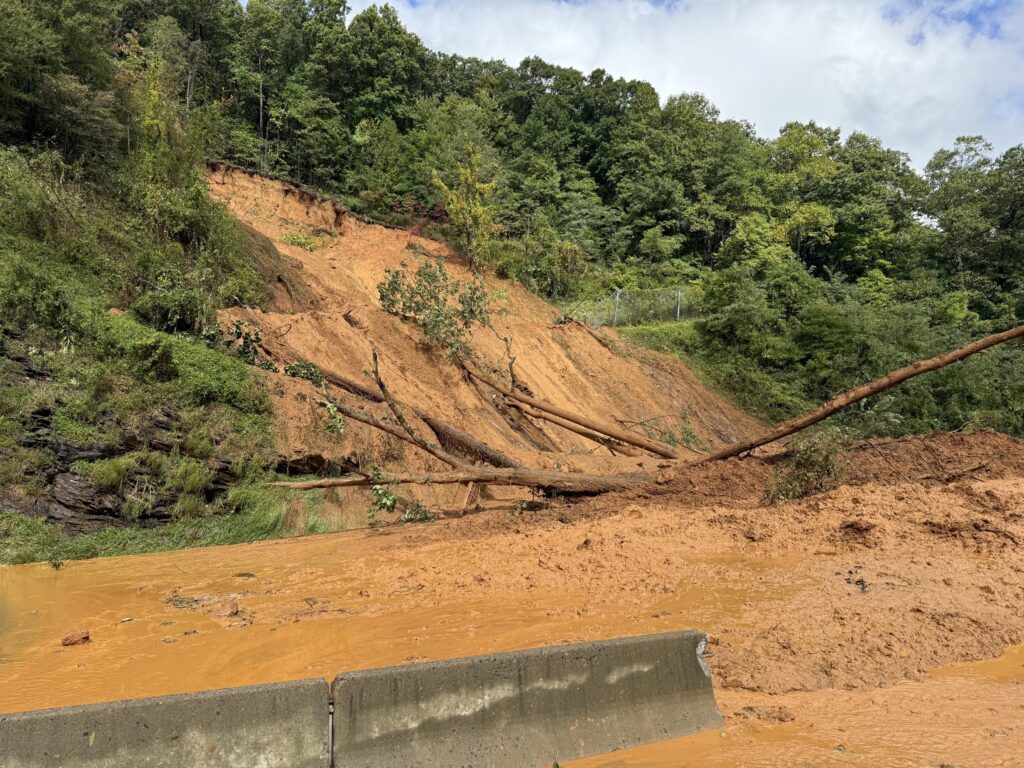Tropical Storm Helene brought flooding and mudslides to western North Carolina. This NCDOT photo taken on September 27, 2024 shows I-40 near Old Fort in McDowell County. (Photo: NCDOT)
Governor Roy Cooper is requesting President Joe Biden issue a major disaster declaration for North Carolina in the aftermath of Tropical Storm Helene. In a Friday letter to the Biden administration, Cooper said that 38 counties sustained significant amount of damage and other impacts associated with Helene that exceed the local and state capacity to recover.
The North Carolina Department of Transportation reported Saturday morning that over 400 roads remain closed across the state.
“All roads in Western NC should be considered closed,” shared NCDOT along with a map to show how dire the situation is.
NCDOT map shared on Saturday, September 28, 2024 shows the extent of damage caused by Helene. (Graphic: NCDOT)
The NCDOT is reminding motorists as work crews begin to clear and inspect roads and bridges, to please give them room.
Hurricane Helene entered the Florida panhandle as a Category 4 hurricane bringing significant, damaging, and life-threatening flash flooding across the western portions of the North Carolina mountains.
Rainfall amounts through midday on Friday reached up to 20 inches in some locations. Major highway closures, major transportation stoppages, and numerous landslides with large damaging debris were reported along the Blue Ridge Escarpment and in western North Carolina.
In the very earliest damage assessments, Emergency Management has recorded two confirmed deaths, hundreds of road closures, assisted living homes damaged and evacuated, over 900,000 homes and businesses with power outages, with at least seven major rivers at moderate to major flood risk level.
Some of the most devastating images coming out of the storm appear to be in Chimney Rock.
Even as the water recedes there will be debris on the roadways. This NCDOT photo shared on Friday, September 27, 2024 shows US-74 submerged. (Photo: NCDOT)
While the western part of the state experienced raging rivers and mudslides, 15 people were injured when an EF3 tornado touched down in the eastern North Carolina city of Rocky Mount.
Gov. Cooper said that the unusual severity and magnitude of an effective recovery is beyond the capabilities of the state and local governments.
“The State has expended an extraordinary amount of money on Stafford Act and non-Stafford Act disasters in the previous five years, as well as the current fiscal year. With the recent impacts of Tropical Storm Debby, Potential Tropical Cyclone Eight, and now Helene, there are many impacts that will need to be addressed,” Cooper wrote in requesting federal assistance.
North Carolina’s request for direct federal assistance includes the need for generators, food, water, shelter supplies, evacuation assistance, non-congregate and congregate shelter assistance, medical assistance and other response measures.
The declaration will start the process for providing critical financial assistance to people and communities hit hard by the storm.
Counties impacted by Tropical Storm Helene include: Alexander, Alleghany, Ashe, Avery, Buncombe, Burke, Cabarrus, Caldwell, Catawba, Cherokee, Clay, Cleveland, Eastern Band of Cherokee Indians, Forsyth, Gaston, Graham, Haywood, Henderson, Iredell, Jackson, Lee, Lincoln, Macon, Madison, McDowell, Mecklenburg, Mitchell, Nash, Polk, Rowan, Rutherford, Stanly, Surry, Swain, Transylvania, Union, Yadkin, Yancey, Watauga, and Wilkes.
Helene caused extensive repair work for Duke Energy. (Photo: Duke Energy)
Duke Energy reports that restoration efforts in Carolinas are well underway after Helene caused 1.7 million customer outages.
The utility had restored service to more than 380,000 customers by late Friday, however Duke notes that for many in western North Carolina and the Upstate of South Carolina should prepare for potential multiday outages.
In advance of the storm, Duke Energy staged equipment and 11,000 workers at strategic locations across the Carolinas. The workforce includes Duke Energy employees and contractors normally based in the Carolinas and individuals from other electric companies in 19 U.S. states and Canada.

